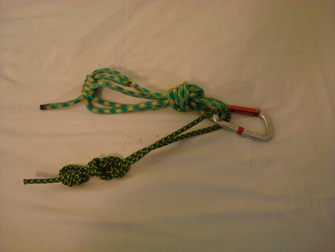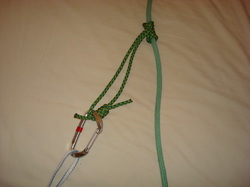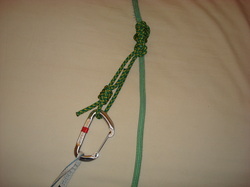The Ascending Knots
|
There are three knots that work for ascending a rope - the Prusik Knot,
the Klemheist Knot and the Bachman Knot. We almost always use the
Prusik Knot, since it's more secure than the Bachman Knot and easier to
loosen than the Klemheist Knot. The Bachman Knot also requires a
locking carabiner, and is fussy to tie and to use. We think the Prusik
is best for most applications. Check out our article on the Prusik Knot for pictures and a demonstration. To learn to tie the Klemheist, check out our page on the Klemheist Knot.
These knots work by tightening under load. They will cinch down on the rope and will not slide. The Klemheist and Bachman Knots only move easily in one direction. You can release all of them by grasping them and twisting slightly, then sliding up or down. |
How to Perform a Basic Ascent on a Rope
Ascending relies on the concept that the rope can only travel one direction through the ascender, or only when your ascending knot is unloaded. To move up the rope, you will need two ascenders or knots, one attached to your harness, and one attached to the line with a loop for your foot. We use our longer cordelette for our foot, and our shorter one for our harness. Sometimes we attach the harness cordelette to our personal anchor system for a bit more extension. The line attached to your harness must be above the line for your foot. If you are using knots, tie a Prusik Knot on the rope with the shorter cordelette and clip it to your harness or personal anchor with a locking carabiner. Next, tie your foot Prusik Knot below the harness Prussik using your longer cordelette, leaving it low enough that you can get your foot in the loop. If it is too long, tie an overhand knot to shorten it up. If you are using ascenders, attach both ascenders to the rope and clip into the upper ascender with your personal anchor. If you have an aid ladder, you can use that for your foot, otherwise clip a short length of cordelette into the lower ascender. You are now ready to ascend.
To move up the rope, you will weight the knot or ascender attached to your harness, then slide the foot knot up until the knee of the leg in that loop is bent to about 90 degrees. You will then stand up on the foot knot, and, balancing, slide the harness knot up as far as you can. You have just advanced up the rope! Just keep repeating this process until you are where you want to be.
If you are using ascenders, be sure to tie a Figure-Eight on a Bight in your rope every 20 feet or so, and clip it with a locking carabiner to your harness. This insures that if your ascenders come off the rope, you won't fall all the way to the bottom of the rope. Below, Chris McNamara demonstrates how to tie backup knots when you are jumaring on a big wall. The technique is the same for shorter jumars.
To move up the rope, you will weight the knot or ascender attached to your harness, then slide the foot knot up until the knee of the leg in that loop is bent to about 90 degrees. You will then stand up on the foot knot, and, balancing, slide the harness knot up as far as you can. You have just advanced up the rope! Just keep repeating this process until you are where you want to be.
If you are using ascenders, be sure to tie a Figure-Eight on a Bight in your rope every 20 feet or so, and clip it with a locking carabiner to your harness. This insures that if your ascenders come off the rope, you won't fall all the way to the bottom of the rope. Below, Chris McNamara demonstrates how to tie backup knots when you are jumaring on a big wall. The technique is the same for shorter jumars.
Two Foot Ascending
This technique is mostly for following in aid climbing. You will need two ascenders and either two aid ladders or two measured loops of cord or webbing. Attach one loop or aid ladder to each ascender, and attach your personal anchor to the top ascender. As you ascend, you will lean forward onto the rope, and push up the ascender that you aren't weighting, almost like walking up the wall. This system doesn't work well with friction knots, because they are too hard to slide up the rope. Mainly, you will only use this technique in aid situations. Below, Chris McNamara for SuperTopo.com gives another stellar demonstration of the proper technique.



